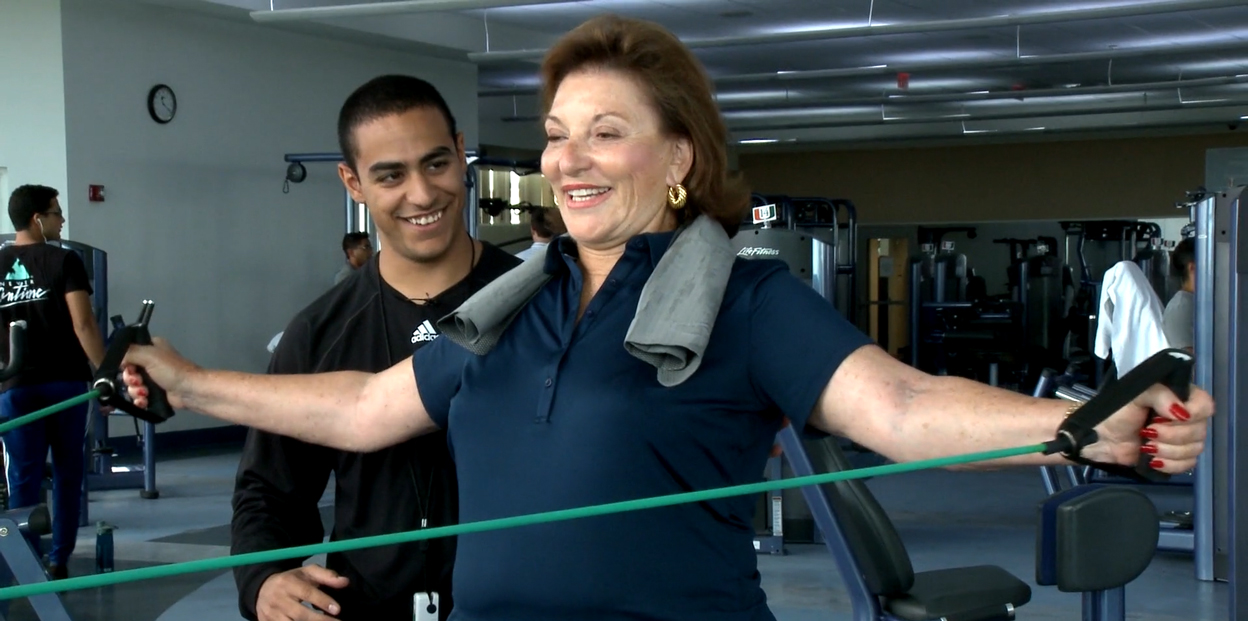Program Offers Participants Individualized Fitness Plans

A lack of regular exercise leads to and worsens a variety of health issues. This is a fact that Linda Eads and Norman Altman know all too well.
Both had health issues when they entered the Supervised Exercise Program at the University of Miami Health System’s Fitness and Wellness Center.
Linda Eads entered the program offered by UHealth because “I had high cholesterol, my legs and hips hurt — and I hated to sweat.” Whereas, Norman Altman “had an illness that caused neuropathy. After it was successfully treated, I realized I needed to get into a regular exercise program.” And, although they had different incentives for signing up, they both realized they needed help with physical fitness.
“Many people think that exercise is for looking good in a bathing suit,” said Tony Musto, director of fitness programs at the UHealth Fitness and Wellness Center, where the Supervised Exercise Program is offered, “but what we have built since its original launch on the Coral Gables campus in 2001 is a medically based program focused on cardiovascular health.”
He explains that their typical participant is someone who is sedentary and has multiple risk factors for cardiovascular disease. Their doctor may have told them to start exercising, but they may not know where to go, or they may be reluctant to exercise because they don’t feel safe. Tony says that through the program they watch and measure the participants, so they can help them progress.
“I feel terrific now!”
Eads, an educational entrepreneur, typifies many of the Supervised Exercise Program’s participants — constantly on the go but too busy to exercise.
“I needed a customized program because I travel every two weeks,” said Eads. “In addition, somebody who never liked to exercise is not a piece of cake to work with. Nonetheless, it worked out beautifully. I have shaped up, my breathing is better, and I feel terrific now. Young people have trouble keeping up with me!”
Altman, who serves as the ombudsperson for the Miller School of Medicine, has also gained multiple benefits from the program.

“I have no cardiovascular problems, but we are working to strengthen that system to keep problems from developing,” he said. “Exercise helps so many areas. One of the benefits is that I’m able to lose some weight. It’s a great combination.”
Fitness based on your health needs
The key, says Musto, is that the program’s two health and fitness specialists, Michael Bello and Alexis Canaves, develop an individualized exercise regimen for each participant.
“First, we do a pre-assessment that tells us where to start you,” he said. “We constantly measure variables, such as heart rate and blood pressure, to determine when it is safe to progress you. Since we are monitoring the session, it allows us to progress people a little more aggressively than if they exercised alone. At the end, we do a post-assessment to see how much you have improved. Then we give you an exit program so you can continue on your own.”
So far, he reports, more than 80 people have completed the program, and many have continued exercising. Some opt to do so on their own, while others who prefer guidance work with one of the center’s trainers.
The Supervised Exercise Program is available to UM faculty, staff, students and the public. To be eligible for the program, candidates must have a referral from their physician and possess at least two of the following risk factors:
- Obesity (BMI above 30 or waist more than 40 inches for men and more than 35 inches for women).
- High blood pressure or on blood pressure medication.
- High cholesterol or on cholesterol medication.
- Pre-diabetic/diabetic or on blood sugar medication.
- Sedentary (having exercised less than three days a week for at least six months).
Each participant is given an initial fitness assessment that is used to create a personalized exercise prescription that includes a series of goals. Classes are a mix of cardiovascular exercise and a weight-training circuit. The cardiovascular portion initially is 20 minutes long and progresses to 40 minutes over time. The weight-training portion is a seven-exercise circuit using machines that work the major muscle groups.
The UHealth Fitness and Wellness Center is located on the ninth floor of the Don Soffer Clinical Research Center. Additional information is available at the Supervised Exercise Program website or by calling 305-243-7802 or emailing [email protected].
Tags: exercise, healthy living, Supervised Exercise Program, Tony Musto, UHealth Fitness and Wellness Center
